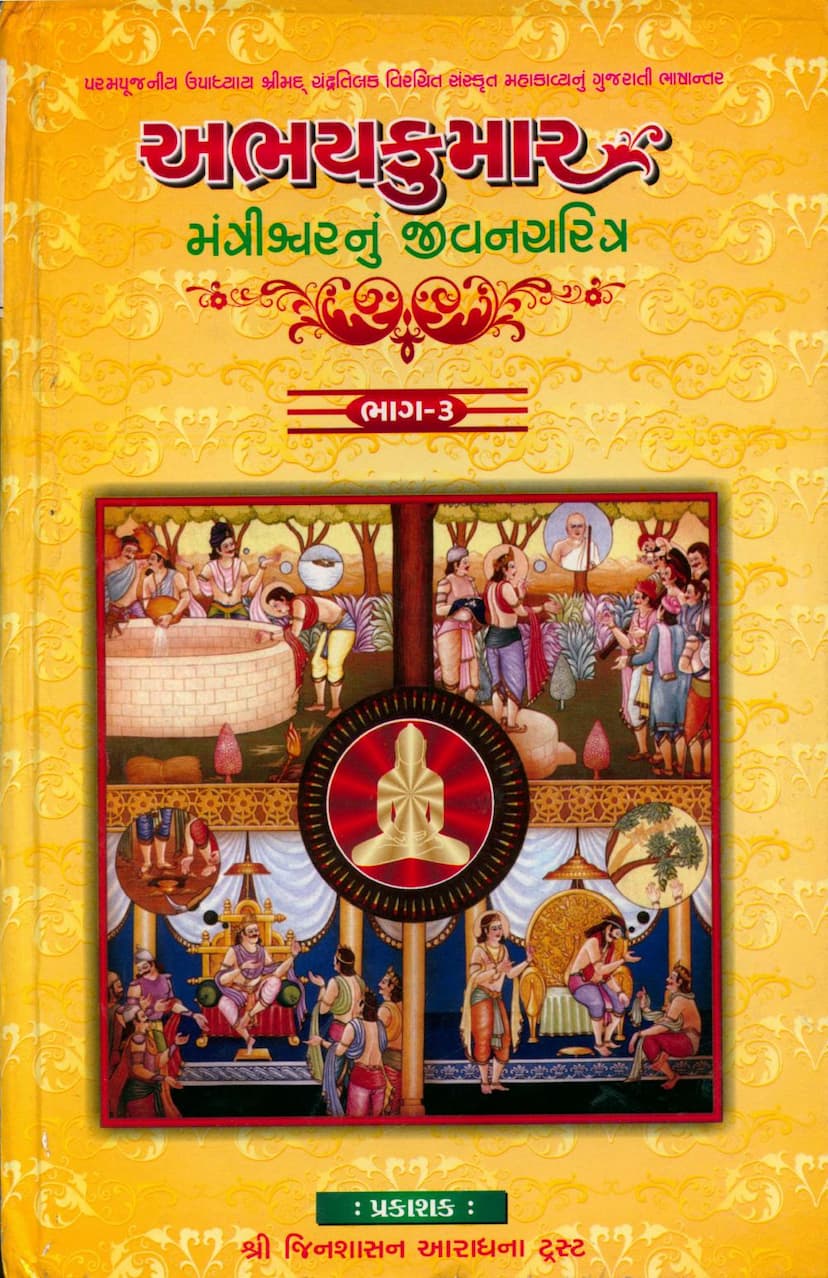Abhaykumar Mantrishwar Jivan Charitra Part 03
Added to library: September 1, 2025

Summary
This is a comprehensive summary of "Abhaykumar Mantrishwar Jivan Charitra Part 03" by Motichand Oghavji and Satyasundarvijay, published by Jinshasan Aradhana Trust.
Overall Theme: This third volume of the biography of Abhaykumar, the minister, continues to detail his virtuous life, spiritual journey, and significant interactions within the framework of Jainism. It highlights his wisdom, devotion, and adherence to Jain principles.
Key Sections and Narratives:
Sarg Dashamo (Chapter Ten): The Woodcutter's Grievous Suffering and Other Tales
- The Woodcutter's Conversion: The chapter begins with the arrival of Sudharma Ganadhar in Rajgriha. A woodcutter is deeply affected by the sermon and requests initiation into monkhood. Despite societal mockery about his past profession, he is initiated and diligently follows the monastic path.
- Abhaykumar's Wisdom and Charity: Abhaykumar demonstrates his intelligence and generosity by orchestrating a public distribution of jewels, contingent on people renouncing women, bathing, and fire. This highlights the value of detachment and leads to a deeper understanding of true wealth and sacrifice.
- The Value of Human Life: A pivotal discussion occurs in King Shrenik's court regarding the most valuable commodity. While others offer various answers, Abhaykumar asserts that human flesh is the most valuable, sparking debate. He later proves this by his inability to obtain even a small amount for a supposed medicinal purpose, underscoring the rarity and preciousness of human existence.
- The Blind and the Crippled Analogy: Lord Mahavir uses the well-known parable of the blind man and the crippled man to illustrate the necessity of both knowledge (Jnan) and conduct (Kriya) for liberation. The blind man has legs but no sight, while the crippled man has sight but no legs. Together, they can overcome obstacles. This principle is further reinforced by a contrasting example where the blind and crippled individual fails due to lack of cooperation, emphasizing the importance of coordinated effort in spiritual practice.
- The Power of the Navkar Mantra: The text emphasizes the immense power of the Navkar mantra through various anecdotes, illustrating its ability to protect, grant wishes, and even influence supernatural beings.
- The King's Inquiry into Dharma: King Shrenik seeks to understand the prevalence of righteous versus sinful individuals in society. Abhaykumar devises an ingenious test by building two temples, one white for the righteous and one dark for the unrighteous. The people's choices reveal that many falsely claim righteousness, while only a few genuinely embrace it, highlighting the importance of introspection and true adherence to dharma.
Sarg Egaramo (Chapter Eleven): Lord Mahavir's Arrival and the Power of the Navkar Mantra
- Abhaykumar's Ascendancy: This section details Abhaykumar's continued exemplary service as a minister, managing the kingdom with unparalleled wisdom and fulfilling his duties while maintaining detachment.
- King Shrenik's Renunciation: King Shrenik, inspired by the desire to pursue spiritual practices, decides to abdicate and pass the kingdom to Abhaykumar. However, Abhaykumar, recognizing the potential pitfalls of worldly life, respectfully delays accepting the throne, indicating his inclination towards renunciation.
- Lord Mahavir's Teachings on Knowledge and Conduct: Lord Mahavir's discourse focuses on the path to liberation, emphasizing the indispensable combination of knowledge and conduct. The parable of the blind and the crippled is elaborated upon.
- The Navkar Mantra's Efficacy: This chapter extensively narrates the multifaceted benefits of chanting the Navkar mantra. It is presented as a source of health, prosperity, protection, and ultimately, liberation. Several stories illustrate how the mantra saved individuals from death, misfortune, and even supernatural dangers.
- The Story of Prince Udhyan: The narrative introduces Prince Udhyan, his virtuous queen Prabhavati, and his nephew Keshi. The story of Kumarnandi, a wealthy goldsmith, and his entanglement with demonic beings highlights the dangers of lust and attachment. The text also describes the mystical Nandishwar Island.
- The King Udhyan's Ordeal: Prince Udhyan faces significant challenges, including the theft of a divine idol. His journey to reclaim it, his confrontation with King Chand Pradyot, and his eventual victory are detailed, showcasing his valor and strategic prowess.
- Queen Prabhavati's Renunciation and Salvation: Queen Prabhavati's piety, her embrace of Jain principles, and her eventual renunciation and attainment of heaven are described.
- The Tale of the Four Daughters-in-Law: A significant portion describes the test conducted by Sheth Dhanavah, where he gives five grains of paddy to each of his four daughters-in-law to assess their character and adherence to his principles. This story serves as a moral lesson on diligence, contentment, and the consequences of greed and neglect. Rohini, the fourth daughter-in-law, demonstrates exceptional foresight and diligence, leading to her prosperity and recognition. This narrative is used by Lord Mahavir to explain the principles of righteous conduct and the importance of adhering to vows.
- Prince Abhaykumar's Renunciation: Upon witnessing the spiritual inclination of his parents and the teachings of Lord Mahavir, Abhaykumar makes the profound decision to renounce worldly life and embrace monkhood. His departure is marked by elaborate ceremonies and the heartfelt blessings of his family and the populace. The text describes his initiation, his profound understanding of scriptures, and his virtuous life as a muni, culminating in his ultimate salvation.
- Prince Abhay's spiritual discipline: The narrative highlights Abhaykumar's unwavering commitment to his vows, his mastery of scriptures, and his ability to overcome inner enemies like anger, pride, and greed. His solitary travels and discourses are mentioned, illustrating his spiritual attainment.
- The Battle of Charitra Raja and Anangaraja: The text includes a metaphorical battle narrative where virtues (Charitra Raja) triumph over vices (Anangaraja), emphasizing the internal spiritual struggle.
- Abhay Muni's Final Liberation: The chapter concludes with Abhay Muni's final spiritual practices, his peaceful death, and his rebirth in the Sarvartha Siddhi heaven.
In essence, this volume paints a detailed picture of Abhaykumar's transformation from a wise minister to an accomplished ascetic, emphasizing the Jain principles of non-violence, detachment, knowledge, conduct, and the ultimate pursuit of liberation.